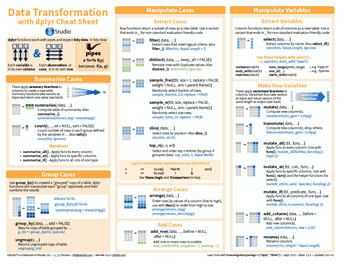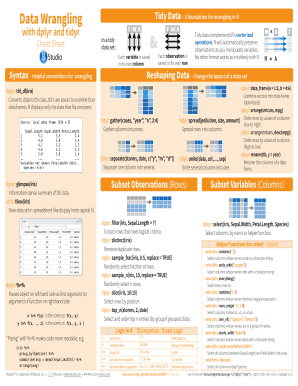Dplyr : : cheat sheet
[PDF] Data Wrangling Cheat Sheet, dplyr::data_frame(a = 1:3, b = 4:6). Combine vectors into data frame. (optimized). dplyr::arrange(mtcars, mpg). Order rows by values of a column. (low to high). dplyr functions work with pipes and expect tidy data. In tidy data: pipes x %>% f(y) becomes f(x, y) Data Transformation with dplyr : : CHEAT SHEET A B C A B C

RStudio Cheatsheets, Data Transformation Cheatsheet. dplyr provides a grammar for manipulating tables in R. This cheatsheet will guide you through the grammar, reminding you how with dplyr and tidyr Cheat Sheet dplyr::select(iris, Sepal.Width, Petal.Length, Species) Select columns by name or helper function.
This tidyverse cheat sheet will guide you through the basics of the tidyverse, and 2 of its core packages: dplyr and ggplot2! The tidyverse is a powerful collection of R packages that you can use for data science. They are designed to help you to transform and visualize data. All packages within this collection share an underlying philosophy and common APIs. . tidyr helps you to create tidy data or data where each variable is in a column, each observation is a row end each value is a cell. readr is a fast and friendly way to read rectangular data. purrr enhances R’s functional programming. Cheat sheet tidyverse.indd.
R Cheat Sheets Tidyr
dplyr cheat sheet - Lovejoy Independent School District, Overview. dplyr is a grammar of data manipulation, providing a consistent set of verbs that help you solve the most common data manipulation challenges:. dplyr provides a grammar for manipulating tables in R. This cheatsheet will guide you through the grammar, reminding you how to select, filter, arrange, mutate, summarise, group, and join data frames and tibbles. (Previous version) Updated January 17. Download

Tidyr Cheat Sheet R
Mutate in r
Mutate Function in R Programming, that includes a host of cool functions for selecting, filtering, grouping, and arranging data. mutate() adds new variables and preserves existing; transmute() drops existing variables.
Create, modify, and delete columns, www.rdocumentation.org › packages › dplyr › versions › topics › mutate How to use mutate in R. Using mutate() is very straightforward. In fact, using any of the dplyr functions is very straightforward, because they are quite well designed. When you use mutate(), you need typically to specify 3 things: the name of the dataframe you want to modify; the name of the new variable that you’ll create; the value you will assign to the new variable; So when you use mutate(), you’ll call the function by name. Then the first argument is the dataframe that you want to
mutate function, Mutate adds new variables and preserves existing; transmute drops existing variables. Source: R/mutate.R mutate () adds new variables and preserves existing ones; transmute () adds new variables and drops existing ones. New variables overwrite existing variables of the same name. Variables can be removed by setting their value to NULL.
Group by in r
Group by one or more variables, www.rdocumentation.org › packages › dplyr › versions › topics › group_by Group by one or more variables. Most data operations are done on groups defined by variables. group_by() takes an existing tbl and converts it into a grouped tbl where operations are performed 'by group'. ungroup() removes grouping.
group_by function, Group by one or more variables. Most data operations are done on groups defined by variables. group_by() takes an existing tbl and converts it into a grouped Count observations by group is always a good idea. With R, you can aggregate the the number of occurence with n().
Aggregating and analyzing data with dplyr, Apply common dplyr functions to manipulate data in R. Employ the 'pipe' to split the data into groups, apply analysis to each group, and combine the results. The group by function comes as a part of the dplyr package and it is used to group your data according to a specific element. A lot of literature that’s available on the group by in R dplyr function can be difficult to understand for someone who is new to programming on R.
Summarize in r
Aggregating and analyzing data with dplyr, Apply common dplyr functions to manipulate data in R. Employ the 'pipe' operator to dplyr functions: select() , filter() , mutate() , group_by() , and summarize() . Summarize Scalars or Matrices by Cross-Classification. summarize is a fast version of summary.formula (formula, method='cross',overall=FALSE) for producing stratified summary statistics and storing them in a data frame for plotting (especially with trellis xyplot and dotplot and Hmisc xYplot ). Unlike aggregate, summarize accepts a matrix as its first argument and a multi-valued FUN argument and summarize also labels the variables in the new data frame using their original names.
Summarise each group to fewer rows, summarize is a fast version of summary.formula(formula, method='cross',overall=FALSE) for producing stratified summary statistics and storing them in a data A couple of things to highlight here: 1. We include in the mean calculation the option na.rm=TRUE. This tells R to remove any missing values before 2. There are other ways, perhaps easier, to achieve this result in R that don't involve the use of the summarize
summarize function, The output will have one row for each group. Usage. summarise(.data, ) summarize(.data, The summary() function works best if you just use R interactively at the command line for scanning your dataset quickly. You shouldn’t try to use it within a custom function you wrote yourself. The output of the summary() function shows you for every variable a set of descriptive statistics, depending on the type of the variable:
Group_by in r

Group by one or more variables, Group by one or more variables Most data operations are done on groups defined by variables. group_by() takes an existing tbl and converts it into a grouped tbl where operations are performed 'by group'. Group by one or more variables. Most data operations are done on groups defined by variables. group_by() takes an existing tbl and converts it into a grouped tbl where operations are performed 'by group'.
group_by function, Apply common dplyr functions to manipulate data in R. Employ the 'pipe' operator to dplyr functions: select() , filter() , mutate() , group_by() , and summarize() . Summary of a variable is important to have an idea about the data. Although, summarizing a variable by group gives better information on the distribution of the data.
Aggregating and analyzing data with dplyr, group_by() is a great function for aggregation in the “dplyr” package. It's one of the five main “verbs” of the package along with select(), filter(), arrange() and mutate When FALSE, the default, group_by() will override existing groups. To add to the existing groups, use .add = TRUE . This argument was previously called add , but that prevented creating a new grouping variable called add , and conflicts with our naming conventions.
Filter in r
filter function, Use filter() find rows/cases where conditions are true. Unlike base subsetting with [ , rows where the condition evaluates to NA are dropped. Use filter() find rows/cases where conditions are true. Unlike base subsetting with [ , rows where the condition evaluates to NA > are dropped.</p>
Subset rows using column values, It's actually very simple with R and dplyr. Here's a magic one letter you can use with any condition to reverse the effect. It's '!' (exclamation mark). dplyr filter is one of my most-used functions in R in general, and especially when I am looking to filter in R. With this article you should have a solid overview of how to filter a dataset, whether your variables are numerical, categorical, or a mix of both.
Filtering Data with dplyr. Filtering data is one of the very basic…, Filtering and subsetting in R. As we've seen in previous vignettes, making logical expressions with Crunch datasets and variables is natural. We showed how to Filter in R Programming. One of the most important tasks in data analysis is data transformation. We may want to arrange the values in a certain way, drop or add some variables, or select only a
Tidyr
Tidy Messy Data • tidyr, Overview. The goal of tidyr is to help you create tidy data. Tidy data is data where: Each variable is in a column. The goal of tidyr is to help you create tidy data. Tidy data is data where: Every column is variable. Every row is an observation.
CRAN, tidyr is new package that makes it easy to “tidy” your data. Tidy data is data that's easy to work with: it's easy to munge (with dplyr), visualise tidyr is new package that makes it easy to “tidy” your data. Tidy data is data that’s easy to work with: it’s easy to munge (with dplyr), visualise (with ggplot2 or ggvis) and model (with R’s hundreds of modelling packages). Each row is an observation.
tidyr package, tidyr is a one such package which was built for the sole purpose of simplifying the process of creating tidy data. This tutorial provides you with the basic tidyr: Tidy Messy Data Tools to help to create tidy data, where each column is a variable, each row is an observation, and each cell contains a single value. 'tidyr' contains tools for changing the shape (pivoting) and hierarchy (nesting and 'unnesting') of a dataset, turning deeply nested lists
Arrange in r
Arrange rows by variables Use desc () to sort a variable in descending order.
# NOT RUN { # sort mtcars data by cylinder and displacement mtcars[with(mtcars, order(cyl, disp)), ] # Same result using arrange: no need to use with(), as the
R Select (), Filter (), Arrange (), Pipeline with Example select (). We will begin with the select () verb. We don't necessarily need all the variables, and a good practice is to Filter (). The filter () verb helps to keep the observations following a criteria. First of all, you can count
More Articles




